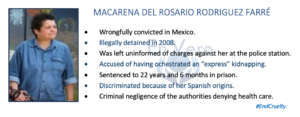Source: El Toque via MXporFCassez (Spanish)
El Toque de RNW (“The Touch”) is an independent multimedia platform for Latin America
Translation: CART / ACDV
Originally published on May 16, 2014
Brenda Quevedo Cruz is one of the suspects accused in the kidnapping and disappearance of Hugo Alberto Wallace, son of social activist and president of the Alto al Secuestro (“Stop the Kidnapping”) association, Isabel Miranda de Wallace. Cruz has been imprisoned for the past eight years without ever being sentenced and is currently locked up in the maximum security prison in the State of Nayarit. In order to have her confess to the alleged crime, she was tortured twice. Despite everything, she refused to comply.
Brenda Quevedo Cruz was tortured for the first time at the Santiaguito de Almoya Social Rehabilitation Prevention Centre in the State of Mexico on the evening of November 27, 2009 at 7:00 p.m. when a prison guard took Brenda to a interrogation room. Enriqueta Cruz Gomez, Brenda’s mother, told El Toque de RNW (“The Touch” an independent multimedia platform for Latin America) that “when the door was opened, Brenda saw three men facing the window. They received orders, put on their masks and made their way towards her” and added that the more Brenda asked the prison guard to hold on to her and not to leave her alone, the less the prison guard listened.
Once inside, continued Enriqueta Cruz Gomez, the men asked her if she knew on behalf of who they came, to which Brenda responded on behalf of Isabel Miranda de Wallace. They then immediately started to insult her, punch her in the stomach and later put a plastic bag over her head and began to suffocate her.
“They warned her not to bother screaming because everyone from the prison director to the prison guards agreed to her being tortured and that no one would pay attention to her.”
“They pulled her hair, they placed her next to a tape recorder and told her that they were tired of her antics and that if they removed their hands from her mouth and she would say something stupid, it would make matters worse. She began to cry and they began to beat her again, covering her mouth and shouting that if she wouldn’t comply, things would get worse and that it would go on all night long,” stated Enriqueta Cruz Gomez.
“In addition, the men threatened that she would be taken out from jail. They later began to touch her genitals and breast with force. Then, they showed her a syringe that was filled with red liquid and claimed that it was HIV-infected blood and that if she did not tell them that she was responsible for the kidnapping along with the names of the other persons involved, they were going to inject her every month until she signed the confession that she was responsible for the kidnapping,” said Brenda’s mother. She added that this tactic happened over an hour and a half until the prison guards knocked on the door.
Brenda Quevedo Cruz was tortured for the second time on October 13, 2010 at noon in Islas Marias. About five or six men were on location in a half-built house where she was held incommunicado. The torture, maintains Enriqueta Cruz Gomez, “was brutal regardless of the beatings, waterboarding, and plastic bag asphyxia; there was also rape.” She added that Brenda was certain that they placed something in her vagina while she was handcuffed.
The men told her that if she did not sign the confession, they would go after her family, her mother and her brother, and that they knew where to find them. At a certain point, the men pulled away but before they left, one of them told Brenda to repeat the reason why she was there. She replied that she was there for the kidnapping of Hugo Alberto Wallace and the man answered, “No, to you that’s Mr. Hugo Alberto Wallace!” with a slap to Brenda’s face.
When the men finally left, one of them came back and gave her another slap in the face, said Enriqueta Cruz Gomez and added that Brenda ”felt that she had lost her hearing and that she remained deaf for a long time,” and insisted that the torture was very brutal.
“Having been tortured twice, my daughter obviously remained severely affected by everything they did: the waterboarding, the electric shocks, the plastic bag asphyxia, the threats and rape,” explains Brenda’s mother.
Brenda was transferred to the Islas Marias prison despite the fact that she was never sentenced. For Enriqueta Cruz Gomez and her family, it seemed as if she was being kidnapped and she claimed that more than 40 hours had passed before they told her where they had taken her. A prison liaison officer who admitted that he was responsible said that they had taken her to the airport. Brenda’s mother points out that not even the judge, the lawyer, or the family knew why they had taken her away. “When I filed the complaint, the first thing the judge requested was a report on why they had transferred Brenda (from Santiaguito) without prior notice,” said Enriqueta Cruz Gomez. She added that after an initial investigation, according to the authorities, her transfer was justified because it was a question of security, her profile and the charges that were laid against her.
Enriqueta Cruz Gomez filed a complaint a year ago before Jesus Murillo Karam of the Office of the Attorney General of the Republic against Raul Plasencia Villaneuva, Ombudsman of the National Commission on Human Rights (NCHR) for his omitting to act in the case of torture of her daughter. She states that when Brenda had been relocated to the maximum security prison in Tepic, Nayarit after the incident in Islas Marias, they began to punish her without any reason. Enriqueta Cruz Gomez began again to send requests and complaints to the NCHR. Brenda was then transferred to a punishment cell called the Apando, a very small cell measuring 2×3 metres that contained a spotlight, a recording camera, a washroom and a shower.
“They kept her under surveillance for 24 hours a day and treated her like an animal. They didn’t let her out and brought in her food,” stressed Brenda’s mother and added that she remained there for two months.
In a conversation between Brenda and the psychologist that examined her in the Islas Marias prison, it was discovered that the NCHR had in fact lied in a report dated September 2011, in which the results of the investigation into the Islas Marias prison showed that nothing happened. After hearing about this, the psychologist said that this was impossible since she had made an evaluation in July 2011 based on the guidelines of the Istanbul Protocol and it was concluded that Brenda was indeed tortured. “The NCHR concealed the information and allowed Brenda to be transferred to the Apando punishment cell,” said Enriqueta Cruz Gomez and added that while she was there, “she had a nervous breakdown because she thought that she was going to be tortured again. For this reason, we are bringing charges against Plascencia Villanueva.” Enriqueta Cruz Gomez cannot say for certain why the NCHR acted in this manner but she suspects that it was because Isabel Miranda de Wallace was supporting Raul Plascencia Villanueva’s candidacy as the next ombudsman (as she found out in the news). In addition, “we think and it is very clear, that all that they did during 2010-2011 was because Plascencia Villanueva was about to award the National Human Rights Prize to Wallace,” points out Enriqueta Cruz Gomez.
Before it was concluded that Brenda’s case was indeed one of torture as based on the guidelines of the Istanbul Protocol, Enriqueta Cruz Gomez claimed that the state of Mexico did not compensate her for the damage caused to her daughter. Only in early February of last year did a psychiatrist follow Brenda given that she was not feeling very well and that she was suffering from insomnia and rapid heartbeat due to the medication she was receiving. The NCHR visited her three times after the charges.
In terms of Brenda’s current physical, mental and emotional state, Enriqueta Cruz Gomez assures that she is “coming out of it little by little” and adds that although she is being followed by a psychotherapist, she is really alone and is now turning to the Bible. In addition, Enriqueta Cruz Gomez mentions that all her medication has been removed as it had severely affected her because they were giving her strong doses. In fact, she was not receiving proper medical care.
Mexico’s hellish justice system
After former President Felipe Calderon declared war on organized crime in 2006, torture has been systematically practiced by Mexican authorities. Since then, alleged victims have experienced ill-treatment, abuse and threats by police and security forces with the goal of obtaining information on organized crime or forcing them to confess their alleged culpability. According to Human Rights Watch, this usually happens between the period when the alleged victims are arbitrarily detained and when they appear in front of the court judge. During this time, the victims are held incommunicado.
As published in Amnesty International’s 2011 report, “Known Abusers, but Victims Ignored: Torture and Ill-treatment in Mexico,” the NCHR received in that year alone, 1669 complaints of torture and ill-treatment adding to a total of 4841 complaints since 2007. The report points out that the information provided by the NCHR “is the most comprehensive data available,” but it stills falls well short of representing the true number of complaints of torture nationwide. As indicated in the report, this is due to the fact that the NCHR only intervenes when federal officials are implicated in abuses. The data collected by the NCHR “does not necessarily include the complaints of torture and ill-treatment committed by state or municipal officials (except when federal officials are also allegedly involved).”
According to Human Rights Watch and as documented in their November 2011 report, “Neither Rights Nor Security,” some of the torture tactics most commonly used by members of all security forces include beatings, electric shocks, plastic bag asphyxia, sexual torture and death threats. During the first year of President Enrique Pena Nieto’s administration, the NCHR through its Ombudsman Raul Plascencia Villanueva received 1506 complaints of torture and cruel treatment representing 30% less than the total complaints received in 2012 during former President Felipe Calderon’s last year in office which amounted to 2113.




